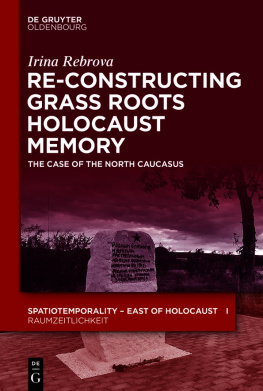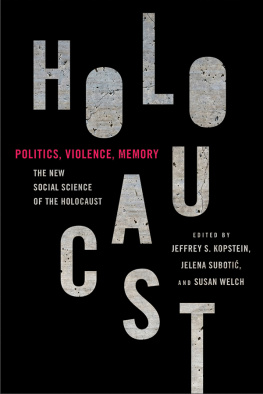Introduction
Ust-Labinsk is a sunny provincial town buried in the verdure of Russias south, 200 km from the foothills of the Western Caucasus, the mountain range that nowadays separates Russia from its southern neighbours. It is situated at the confluence of the Laba and the Kuban rivers, the second of which has given its name to the area, and informally to the larger Krasnodar region itself. The towns history stretches back more than two hundred years to the first construction of military fortifications by General Aleksandr Suvorov during Catherine the Greats Russo-Turkish Wars. It was subsequently occupied by Don Cossacks and became one of their capitals [stanitsa] for many long decades. The principal turning points of Russian and later Soviet history all left their mark on the body of this Kuban village, altering its appearance and affecting the lives of its inhabitants. The Second World War left the deepest wound: a wound that is still bleeding.
Jews were uncommon in the Cossack villages of the south. Yet from July 1941, freight cars full of evacuees and refugees started arriving from the western regions of the Soviet Union, many Jews among them. The family of the surgeon Vladimir (Wolf) Pinkenson came from the Bessarabian town of Bli (Beltsy) and found their new home in Ust-Labinskaya in the autumn of 1941. Pinkensons only son Musya was fond of music and learned to play the violin. Musyas new schoolmates remembered him as a talented musician who often gave concerts in the Soviet military hospital. He graduated with honours from the fifth grade in the spring of 1942, and his teachers remembered him as an exemplary schoolboy and pioneer. He had the bright imprint of a happy childhood. However, in the summer of 1942, war broke into the village and Ust-Labinskaya fell under Nazi occupation for more than six months between August 8, 1942 and February 2, 1943. During this period, as the official Soviet account has it, more than 400 innocent Soviet citizens were tortured and shot, including 116 men, 194 women, [and] children aged from 2 months to 15 years. 35 of those murdered were Russians, the rest were Jews. Fleeing from the Nazi genocide in their native towns, these Jews found their deaths in exile in the steppes and mountains of the Caucasus. The Pinkensons father, grandfather, mother and Musya himself were all shot in a ditch prepared in advance in the fortress northeast of the Krasnyi Forshtadt collective farm. After the war, the story of the shooting of this twelve-year-old violinist was lauded as an almost epic example of the courage of young heroes:
Everyone looked on in terror as machine-gun fire wiped out the famous doctors family: his parents, his wife, the doctor himself. And here comes the boys turn already.
Officer, sir, let me play, one last time! asked Musya.
Play? Here? Why not! It is even funny, only schnell, hurry up!
Putting the violin case down, the boy removed the violin carefully and began tuning it. Hundreds of amused and anxious eyes followed his every movement. Facing the enemys machine guns aimed at his chest, the boy waved his bow and began to play with inspiration the Internationale. People seemed to stand still for a moment, and then it resounded all of a sudden, at first timid, then bolder, then bolder still, and louder: This is the final Enraged fascists, coming to themselves, opened fire. Musya fell. The violin fell out of his hands
After the mass killing of Jews in Ust-Labinskaya was registered in a report of the Extraordinary State Commission [Chrezvychainaya gosudarstvennaya komissiya], hereafter ChGK, which had been working in the village in the summer of 1943, the story of the brave pioneer made headlines in local and national newspapers. But the boys ethnicity and cause of death were gradually removed from official heroic Soviet discourse about the Great Patriotic War. The image of a young hero, the boy-violinist, became the topic of many Soviet literary works: short stories, essays, and lyrics.
A modest wartime obelisk built to commemorate this event was replaced in 1971 by an imposing monument adorned with a bas-relief of a smiling boyish face (Figure 1) on the site of the mass grave of 370 civilians. The Ust-Labinsk artist Viktor Smetanin created this monument. It was erected to commemorate the 50th anniversary of the All-Union Pioneer Organisation named after V.I. Lenin. The inscription Eternal Memory to Ust-Labinsk citizens shot in 1942 was carved at the foot of the monument. Another inscription on the other side of the monument reads: Sleep well, it will never happen again! Eternal memory to the fallen in the struggle for freedom and independence of our Motherland. The return to the ideals of Leninism in the 1960s and 1970s was partially linked to the de-Stalinisation [destalinizatsiya] of the Khrushchev era (19531964), but also to the desire of public authorities to control the official memory of the Great Victory by preventing the penetration of various counter-memories, especially of Jews as the main victims of the Nazis, and of Soviet prisoners of war (POWs). The same year (1971) a cartoon Pioneers Violin [Skripka pionera] was made, based on Musyas story. The young cartoon hero is shown as a brave pioneer challenging an evil-looking Nazi, while playing the first notes of the Internationale instead of the merry song he was asked for. Since that time, teachers and schoolchildren of Ust-Labinsk Secondary School No.1 started to collect evidence and relics of Musya Pinkensons life. The collected memories, the restored biography of the boy, his portrait and other objects quickly became the property of a school museum. More than 15 of the best Pioneer units in the district of Ust-Labinsk were named in honour of Musya. The internationalisation of Musyas history is shown in the correspondence between Soviet pioneers and East German schoolchildren; several groups of East German teenagers visited Musyas monument in the 1970s.

Figure 1: Monument at the mass grave of 370 civilians and the pioneer hero Musya Pinkenson, killed by fascist invaders, by Viktor Smetanin, Ust-Labinsk, 1971 (Photo by the author, 2015).
Thus, in official Soviet memorial culture the mass killing of Jews as the main victims of the Nazis was symbolically minimised and replaced, in this particular case, by the heroic image of a pioneer with a violin in his hands before his execution. The violin symbolised a weapon in the struggle with the enemy. Although in a society used to reading between the lines of official narratives, those so inclined could read Musyas ethnicity from his name and even the violin in his hand (a quintessential marker of Jewishness in Soviet and Russian stereotypes), the reasons for the shooting of Musya and other Soviet citizens were of no importance to official Soviet memorial culture, the boys defiance itself was canonised; the story grew like a snowball.







